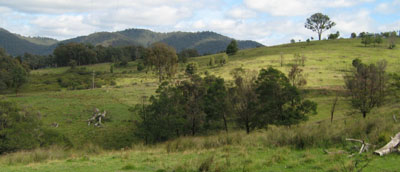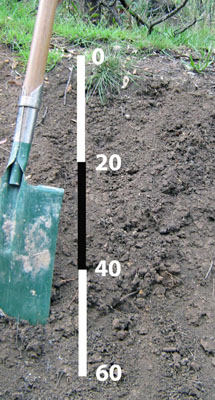EGW30
Location: W Tree
Australian Soil Classification: Haplic, Eutrophic, Black DERMOSOL
Map Unit: W Tree (Component 1)
Previous Site Name: EG30
General Landscape Description: Dissected plateau
Site Description: Upper hill-slope, W aspect 7% slope
Land Use: Grazing
Native Vegetation: Valley grassy forest
Geology: Tertiary basalt

Soil Profile Morphology:
| Surface soil
|
 | ||
| A11 | 0 – 15 cm | Dark brown (10YR3/3); clay loam; moderate medium polyhedral structure; weak consistence moist; few sub-rounded basalt pebbles; pH 6.9; clear change to:
| |
| A12 | 15 – 20 cm | Dark greyish brown (10YR4/2); clay loam; moderate medium polyhedral structure; weak consistence moist; few sub-rounded basalt pebbles ; clear change to: | |
| Subsoil | |||
| 20 – 30 cm | Very dark greyish brown (10YR3/2); light clay; moderate medium prismatic structure parting to medium polyhedral; very firm consistence moderately moist; few (2 - 10%) sub-rounded basalt pebbles ; pH 6.1; gradual change to:
| |
| B21 | 30 – 75 cm | Very dark greyish brown (2.5Y3/2); heavy clay; strong medium prismatic structure parting to medium polyhedral; very firm consistence moderately moist; few sub-rounded basalt pebbles; pH 6.6; gradual change to:
| |
| B22 | 75 – 85+cm | Very dark greyish brown (2.5Y3/2); heavy clay; strong medium prismatic structure parting to medium polyhedral; very firm consistence moderately moist; many sub-rounded basalt fragments. |
Key Profile Features:
- Lack of strong texture contrast between the surface (A11 and A12) and subsoil (B1).
Soil Profile Characteristics:
- | pH | Salinity | ||
Surface soil (A11 horizon) | Slightly acid | Low | Non sodic | None |
Subsoil (B1 horizon) | Slightly acid | Low | Non sodic | None |
Chemical and Physical Analysis:
| Horizon | Horizon Depth (cm) | pH (water) | pH (CaCl2) | EC dS/m | Organic Carbon % | Total Nitrogen % | Free Fe2O3 % w/w | Exchangeable Acididty meq/100g | Exchangeable Cations | Coarse Sand (0.2-2.0 mm) % | Fine Sand (0.02-0.2 mm) % | Silt (0.002-0.02 mm) % | Clay (<0.002 mm) % | Field Capacity % w/w | Wilting Point % w/w | |||
Ca | Mg | K | Na | |||||||||||||||
meq/100g | ||||||||||||||||||
A11 | 0-15 | 6.9 | 6.3 | 0.12 | 2.3 | 0.18 | 11 | 25 | 15 | 0.9 | 0.2 | 14 | 31 | 16 | 24 | 41.1 | 24.1 | |
B1 | 20-30 | 6.1 | 5.2 | 0.11 | 3.15 | 15 | 12 | 10 | 0.33 | 0.47 | 4 | 19 | 36 | 34 | 45.8 | 24.0 | ||
B2 | 30-75 | 6.6 | 5.7 | 0.09 | 3.77 | 13 | 19 | 21 | 0.26 | 0.89 | 20 | 11 | 14 | 54 | 49.7 | 29.7 | ||
Management Considerations
Whole profile
- The profile is slightly acid throughout.
- These soils are very well drained due to their strongly developed subsoil structure.
- Plant available water capacity is considered to be moderate to high (estimated at 108 mm) based on the laboratory data and an effective rooting depth of 100 cm.
- The soil has a low organic matter content. Organic matter will be better maintained under rotational grazing, which enables stronger pasture recovery, rather than set stocking.
- The nutrient holding capacity of the soil is high (based on the sum of the exchangeable basic cations).
- Although the soils are fairly high in iron oxide, the pH is high enough to minimise phosphorus fixation.
- Potassium levels are high and no response to potassium fertilisers would be expected.
- The friable nature of the subsoil allows deep penetration of plant roots.
- The friable nature of the subsoil, together with the shallow depth to rock, can lead to problems with sealing of earth dams.
Profile Described By: David Rees and Grant Boyle, 2000.


